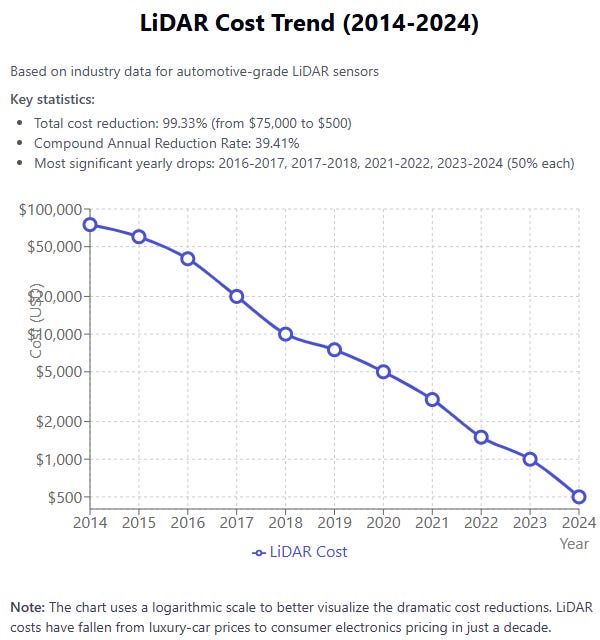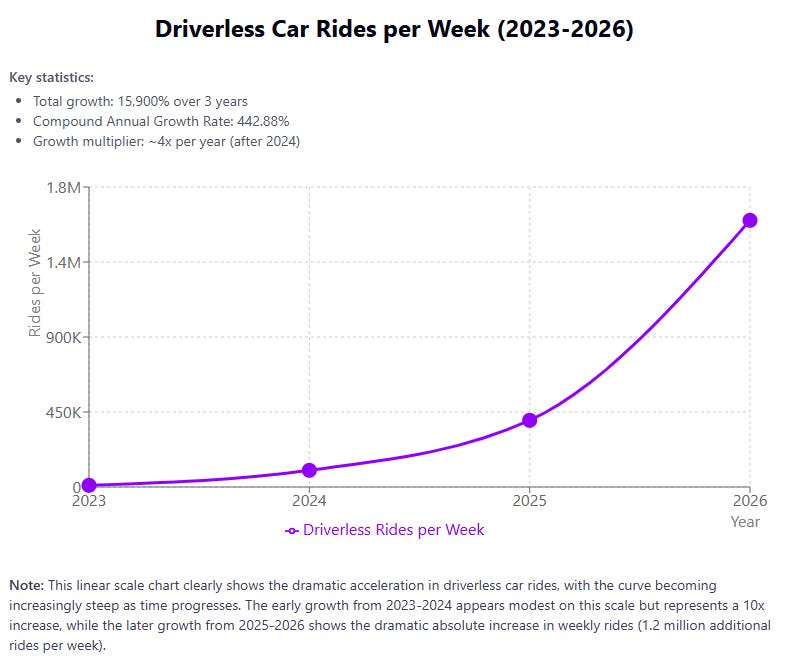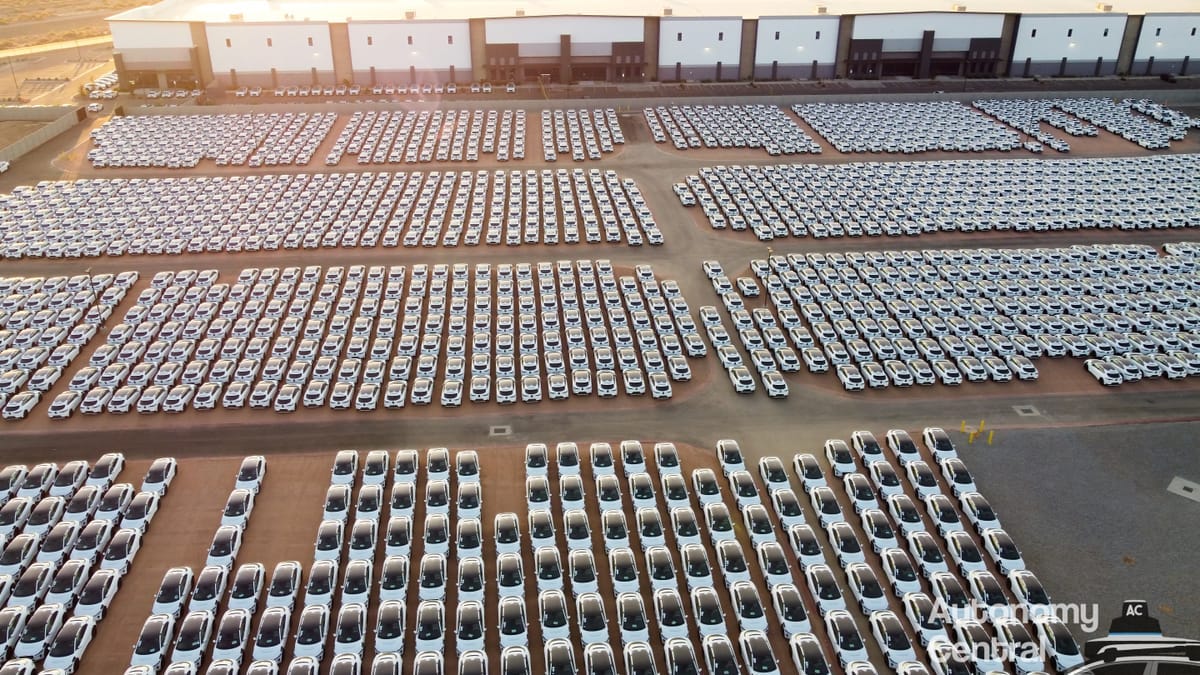Driverless car costs have gotten low enough that we can expect exponential growth from here on out
Driverless Cars are about to start scaling…bigly
Pre-Waymo cutting edge LiDAR systems cost around $75,000 per unit. Uses were mostly limited to military and geographical mapping. If you wanted to build a transport-related solution then you needed at least 3 units. Fast forward to today and these systems are tracking to drop below $1k in total in China. Here’s a chart of what that cost decline looks like
Here’s a log chart to make it clear that costs are still declining rapidly in percent terms from year to year:
LiDAR costs follow what is known as a Wright’s law cost decline. Essentially, for every doubling in production volume the cost per unit declines by an approximately equal percentage. Battery costs have done the same thing:
And the cost of solar panels has done the same thing…
It’s 2025 and I’m sure the vast majority of people are unaware of how precipitously prices for these technologies are falling. The impact of these prices plummeting is either obfuscated from or irrelevant to the daily life of most people.
Mobile Phones have also followed a Wright’s law cost decline, but the decline is hidden in the form of ever better technology. The same thing has happened to computers and AI servers. The cost per unit doesn’t actually drop, but the performance per unit rapidly increases.
What’s exciting about today - 2025 - is that these cost declines are about to become visible to the public. Waymo rides per week are growing exponentially. By the end of…
2023: 10,000 rides per week
2024: 100,000
February 2025: 200,000
Forecasts are all over the place, but extrapolating fleet size based on production rumors gives us something like this. They’re managing 200k rides per week with a fleet not much larger than 1,000 vehicles.
For perspective, there are currently >1,000 Waymos sitting in the lot of their production facility
The cost of a Waymo has dropped from $250k to $150k in the past five years. These costs will fall further when they start using Hyundai in addition to Jaguar to build the vehicles on which their sensors are retrofitted.
If you compare the cost of a vehicle per hour of daily usage, Waymos would therefore be less expensive than a new Toyota Corolla:
Now consider the amount of value delivered to society by freeing up the time spent driving to do other activities. Let’s call it $15/hr. That gives us the following:
What we have is a vehicle that is already less expensive when amortized on a per hour basis than a Corolla - that also re-allocates $1m worth of time over the course of 10 years. This $1m could end up flowing through to digital advertising (people playing games or shopping while they ride), Netflix, or increased productivity for a business. There could also be surprising externalities like improved mental health and decreased demand for anxiety medication (commuting in traffic is stressful, I’m not being hyperbolic, this is a genuine possibility).
If we examine the economics including operating costs of a Waymo vs. an Uber driver in a Corolla the ratio remains surprisingly similar:
Costs are lower than in practice b/c I didn’t look up estimated gas and/or electricity / standard maintenance because they’re all equivalent, but the point is to compare the price between autonomy and human driven rather than to calculate an absolute cost.
This cost difference is why I expect to see a surge in Waymo vehicle production. Costs will only drop as time goes on.
Let’s assume that the number of Waymos on the road doubles every year for the next 2 years and then increases by 50% per year for the 3 years after that (this seems conservative to me). Let’s further assume that Insurance/Connectivity/Tech; Operational Support; and Maintenance (of advanced systems) fall 10% in cost for every doubling of production. That gives us the following in 2030:
If I had to guess, I expect Waymo technology to be doing on the order of 10 million rides per day in 2030. Backing into that figure implies 20 rides per day per vehicle, with 500,000 vehicles on the road. This seems plausible, and would represent approximately .91% of daily trips taken by people around the country (includes bus trips, taxis, any trip taken by a vehicle).












Great to see these LiDAR cost trends.
One comment about your estimated depreciation costs: they should be much higher, for both Waymo and Uber. Driving 3,000+ hours per year would wear out a car in much less than 10 years.
I made a different visual here that estimates cost of Waymo vs. Uber as a percentage of current total Uber fares. It seems like Waymos will become cost competitive once their vehicles are only twice the price of the average Uber driver's car: https://www.2120insights.com/i/152869747/medium-term-is-the-price-right
1) "Pre-Waymo cutting edge LiDAR systems cost around $75,000 per unit. Uses were mostly limited to military and geographical mapping. If you wanted to build a transport-related solution then you needed at least 3 units. Fast forward to today and these systems are tracking to drop below $1k in total in China."
With a $75k unit cost, no wonder Elon has refused to use lidar in Teslas. Now, with sub-$1k unit cost, it won't make sense not to have lidar.
2) Waymo is "managing 200k rides per week with a fleet not much larger than 1,000 vehicles."
The average car is used only 4% of the time. By transcending the human need for sleep, Waymo shows the power of operating cars 50-80% of the time, allowing for the generation of an astounding $1m worth of driver time value compared to a human-driven car.